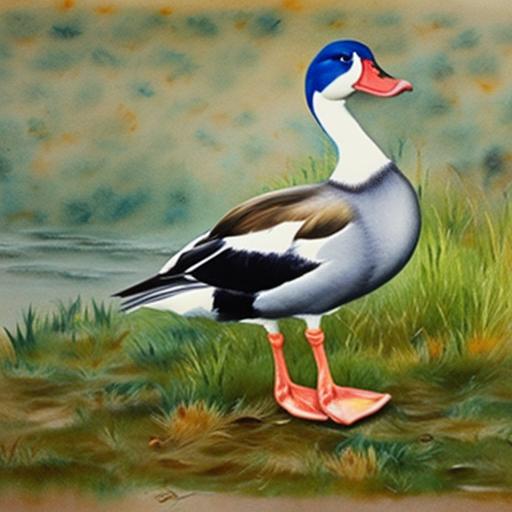Ducks come in a wide variety of breeds, each with its own unique characteristics and traits. Understanding the different duck breeds is essential when considering mixing them. Some popular duck breeds include the Pekin, Mallard, Rouen, Khaki Campbell, and Muscovy. Each breed has its own distinct size, coloration, egg-laying capabilities, and temperament. For example, Pekin ducks are known for their large size and white feathers, while Khaki Campbell ducks are prized for their prolific egg-laying abilities. It’s important to research and understand the specific traits of each breed before deciding to mix them. Additionally, some duck breeds are better suited for certain environments or purposes, such as meat production or egg-laying. By understanding the characteristics of different duck breeds, you can make informed decisions when it comes to mixing them.
Duck breeds also vary in terms of their behavior and temperament. Some breeds are known for being more docile and friendly, while others may be more skittish or aggressive. Understanding the behavior of different duck breeds is crucial when considering mixing them, as certain combinations may not be compatible. For example, Muscovy ducks are known for their calm and friendly nature, while Mallards can be more independent and flighty. It’s important to consider the temperament of each breed when deciding which ones to mix, as this can impact the overall harmony of your flock. By understanding the behavior and temperament of different duck breeds, you can make informed decisions about which ones are best suited for mixing.
Key Takeaways
- Understanding Duck Breeds:
- There are many different duck breeds, each with unique characteristics and traits.
- Factors such as size, temperament, and egg-laying abilities vary among different duck breeds.
- Factors to Consider When Mixing Duck Breeds:
- Consider the compatibility of different breeds in terms of size, temperament, and foraging habits.
- Keep in mind the potential for crossbreeding and the resulting offspring’s characteristics.
- Potential Benefits of Mixing Duck Breeds:
- Increased genetic diversity can lead to healthier and more resilient duck flocks.
- Mixing breeds can also result in unique and desirable traits in the offspring.
- Potential Challenges of Mixing Duck Breeds:
- Aggression and hierarchy issues may arise when mixing different duck breeds.
- Crossbreeding can lead to unpredictable offspring with varying traits.
- Tips for Successfully Mixing Duck Breeds:
- Introduce new breeds gradually and monitor interactions closely.
- Provide ample space and resources to minimize competition and aggression.
- Common Duck Breeds That Can Be Mixed:
- Pekin, Khaki Campbell, and Indian Runner ducks are popular breeds that can be successfully mixed.
- Muscovy, Welsh Harlequin, and Cayuga ducks are also known for their compatibility when mixed.
- Conclusion: Making Informed Decisions about Mixing Duck Breeds:
- Careful consideration of breed characteristics and potential challenges is essential when mixing duck breeds.
- With proper planning and management, mixing duck breeds can lead to a diverse and thriving flock.
Factors to Consider When Mixing Duck Breeds
When it comes to mixing duck breeds, there are several important factors to consider. One key factor is the purpose of mixing the breeds. Are you looking to create a diverse and visually appealing flock, or are you aiming to maximize egg production or meat quality? The purpose of mixing duck breeds will influence the breeds you choose to mix and the overall management of your flock. For example, if you’re focused on egg production, you may want to mix breeds known for their prolific egg-laying abilities, such as Khaki Campbells and Indian Runners. On the other hand, if you’re interested in meat production, you may want to mix breeds known for their large size and meat quality, such as Pekin and Muscovy ducks.
Another important factor to consider when mixing duck breeds is the compatibility of the breeds. Some duck breeds may not get along well with others, leading to aggression or bullying within the flock. It’s important to research the compatibility of different duck breeds before mixing them, taking into account their behavior, size, and temperament. For example, mixing aggressive breeds with more docile ones can lead to conflicts within the flock. Additionally, some breeds may have specific environmental or dietary requirements that need to be considered when mixing them. By carefully considering the purpose of mixing duck breeds and the compatibility of the breeds, you can make informed decisions that will benefit your flock in the long run.
Potential Benefits of Mixing Duck Breeds
Mixing duck breeds can offer several potential benefits for duck owners. One benefit is genetic diversity, which can lead to healthier and more resilient flocks. By mixing different breeds, you can introduce a wider range of genetic traits into your flock, reducing the risk of inbreeding and genetic disorders. This can result in stronger and more adaptable ducks that are better equipped to thrive in various environmental conditions. Additionally, genetic diversity can lead to improved overall flock productivity, such as increased egg production or better meat quality.
Another potential benefit of mixing duck breeds is creating a visually appealing and diverse flock. By combining different breeds with unique coloration and feather patterns, you can create a stunning and eye-catching flock that adds aesthetic value to your farm or homestead. This can be particularly appealing for hobbyists or those interested in showcasing their ducks at fairs or exhibitions. Furthermore, mixing duck breeds can also provide a wider range of products, such as eggs of different sizes and colors, as well as a variety of meat flavors and textures. By considering these potential benefits, duck owners can make informed decisions about mixing breeds that align with their goals and preferences.
Potential Challenges of Mixing Duck Breeds
While there are potential benefits to mixing duck breeds, there are also several challenges that need to be considered. One challenge is managing the different dietary and environmental requirements of mixed breeds. Some duck breeds may have specific dietary needs or environmental preferences that need to be accommodated when mixing them. For example, certain breeds may require specialized diets or housing conditions due to their size or egg-laying capabilities. Additionally, some mixed breeds may have different growth rates or maturity levels, requiring careful management to ensure all ducks receive adequate nutrition and care.
Another potential challenge of mixing duck breeds is managing potential aggression or bullying within the flock. Certain breeds may not get along well with others, leading to conflicts and stress within the flock. This can result in injuries or reduced productivity among the ducks. It’s important to carefully monitor the behavior of mixed breeds and intervene if necessary to prevent aggression or bullying. Additionally, some mixed breeds may exhibit unpredictable breeding behaviors, leading to challenges in managing mating and reproduction within the flock. By considering these potential challenges, duck owners can take proactive measures to address them and ensure a harmonious and productive mixed flock.
Tips for Successfully Mixing Duck Breeds
To successfully mix duck breeds, there are several tips that can help ensure a smooth and harmonious integration of different breeds. One tip is to provide adequate space and resources for the mixed flock. Ducks require ample space for foraging, bathing, and nesting, so it’s important to ensure that your housing and outdoor areas can accommodate the needs of mixed breeds. Providing multiple feeding and watering stations can also help prevent competition and aggression among ducks with different dietary requirements.
Another tip for successfully mixing duck breeds is to carefully monitor the behavior and interactions of the mixed flock. Observing how different breeds interact with each other can help identify any potential conflicts or issues that need to be addressed. Intervening early on can help prevent aggression or bullying within the flock. Additionally, providing enrichment activities such as floating toys or access to natural water sources can help reduce stress and boredom among mixed breeds.
Furthermore, it’s important to provide balanced nutrition for mixed duck breeds. Different breeds may have varying dietary needs based on their size, age, and purpose (e.g., egg-laying or meat production). Working with a poultry nutritionist or veterinarian can help ensure that your mixed flock receives a balanced diet that meets their specific requirements.
Common Duck Breeds That Can Be Mixed

There are several common duck breeds that can be successfully mixed to create diverse and productive flocks. One popular breed for mixing is the Pekin duck, known for its large size and excellent meat quality. Pekin ducks can be mixed with other breeds such as Khaki Campbells or Indian Runners to create a diverse flock with high egg-laying capabilities. Another common breed for mixing is the Muscovy duck, prized for its calm temperament and unique appearance. Muscovy ducks can be mixed with other breeds such as Rouen or Mallards to create visually stunning flocks with a wide range of coloration and feather patterns.
Additionally, the Khaki Campbell duck is a popular choice for mixing due to its prolific egg-laying abilities. Khaki Campbells can be mixed with other breeds such as Cayugas or Swedish ducks to create flocks with a variety of egg colors and sizes. Furthermore, the Indian Runner duck is known for its upright posture and excellent foraging abilities. Indian Runners can be mixed with other breeds such as Buff Orpingtons or Welsh Harlequins to create diverse flocks with unique behavioral traits.
By carefully selecting and mixing common duck breeds, owners can create flocks that are not only visually appealing but also productive in terms of egg-laying or meat production.
Making Informed Decisions about Mixing Duck Breeds
In conclusion, understanding the characteristics of different duck breeds is essential when considering mixing them. Factors such as purpose, compatibility, behavior, and temperament should be carefully considered before making decisions about mixing duck breeds. While there are potential benefits to mixing duck breeds, such as genetic diversity and visual appeal, there are also challenges that need to be addressed, such as managing dietary requirements and preventing aggression within the flock.
By following tips for successful integration and carefully selecting common duck breeds that can be mixed effectively, owners can create diverse and productive flocks that meet their specific goals and preferences. Making informed decisions about mixing duck breeds can lead to healthier, happier ducks and a more enjoyable experience for owners.
Some common duck breeds that can be mixed effectively include Pekin, Khaki Campbell, and Indian Runner ducks. These breeds are known for their friendly and sociable nature, making them easier to integrate into a mixed flock. It is important to consider the size and temperament of each breed when mixing ducks, as well as their egg-laying capabilities and foraging behavior. By carefully selecting compatible breeds and providing a suitable environment for them to thrive, owners can ensure a harmonious and productive flock. Additionally, providing proper care, nutrition, and housing for mixed duck breeds will contribute to their overall health and well-being, leading to a more enjoyable experience for both the ducks and their owners.
If you’re considering mixing different duck breeds, it’s important to understand the potential challenges and benefits. In a related article on PoultryWizard, “What Should You Feed Ducks?” provides valuable insights into the nutritional needs of ducks and how to ensure they thrive in a mixed breed environment. Understanding their dietary requirements is crucial when introducing different duck breeds to your flock. Check out the article for expert advice on keeping your ducks healthy and happy. Learn more here.
FAQs
What are the different duck breeds that can be mixed?
There are numerous duck breeds that can be mixed, including but not limited to Pekin, Mallard, Rouen, Khaki Campbell, and Muscovy ducks.
Can different duck breeds be kept together?
Yes, different duck breeds can be kept together. However, it is important to consider factors such as size, temperament, and space requirements when mixing duck breeds.
What are the considerations when mixing duck breeds?
When mixing duck breeds, it is important to consider the compatibility of the breeds in terms of size, temperament, and space requirements. Additionally, it is important to monitor the ducks for any signs of aggression or bullying.
Can mixed duck breeds reproduce?
Yes, mixed duck breeds can reproduce. However, it is important to note that the offspring may exhibit a combination of traits from both parent breeds.
Are there any potential issues with mixing duck breeds?
Potential issues with mixing duck breeds include aggression between different breeds, potential for hybrid vigor or health issues in offspring, and the need for adequate space and resources to accommodate the mixed flock.
Meet Walter, the feathered-friend fanatic of Florida! Nestled in the sunshine state, Walter struts through life with his feathered companions, clucking his way to happiness. With a coop that’s fancier than a five-star hotel, he’s the Don Juan of the chicken world. When he’s not teaching his hens to do the cha-cha, you’ll find him in a heated debate with his prized rooster, Sir Clucks-a-Lot. Walter’s poultry passion is no yolk; he’s the sunny-side-up guy you never knew you needed in your flock of friends!







